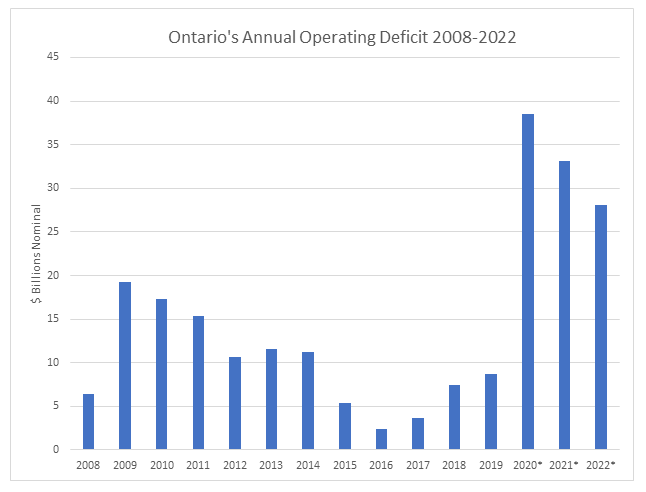Ontario braces for largest budget deficits in provincial history

Before the Ford government tabled Ontario’s 2020/21 budget on Thursday, analysts and budget watchers knew it would likely include the largest deficit in the province’s history. These expectations were met, as the government again forecasted a deficit this year of $38.5 billion—the same as was predicted in its most recent fiscal update.
What was somewhat more surprising was the government’s forecasts for deficits in the years ahead. In fact, its operating deficits will barely shrink at all and will weigh in at $33.1 billion next year and $28.1 billion in 2022/23. This means that by the end of the government’s fiscal plan laid out in this budget, Ontario will have run 15 consecutive operating budget deficits, ending any hope that this year’s large COVID-related deficit would be quickly reduced to prevent the rapid accumulation of more government debt.
To put the scale of the upcoming deficits in perspective, consider that in the 12 fiscal years from 2008 and 2019 inclusive, Ontario’s cumulative budget deficit was $119.4 billion. By comparison, over the next three fiscal years alone, Ontario’s cumulative deficit will hit a forecasted $99.7 billion. Clearly, the pace of debt accumulation has accelerated rapidly.

Of course, the consequence of nearly $100 billion in accumulated deficits will be a rapid increase in the size of the province’s debt burden. As a result, according to the Ford government’s fiscal plan, in 2022/23 net debt (all debts minus financial assets) will be approximately half as large (49.6 per cent) as all of the economic production in the province that year. For this metric (referred to as the debt-to-GDP ratio), Ontario will reach the highest level in its history in each of the next three years, if the government’s forecasts come to pass.
In other words, per-person net debt is on track to reach $30,725 in 2022/23. That’s up from $15,542 (in inflation adjusted 2021 dollars) just 15 years ago. No matter the metric, the story’s the same—rapid debt accumulation.
Of course, the Ford government inherited a difficult situation from its predecessors, which has been made much worse by a pandemic and resulting recession. These terrible developments have put pressure on public health budgets, social assistance and several other areas of public management that have been forced to transform their service delivery models on the fly. Indeed, the government may have to plan and implement policy in the face of uncertainty for some time.
Still, it’s important to understand the cost of the government’s actions, and how they will affect taxpayers now and in the future. For instance, interest payments on Ontario government debt will consume a forecasted $12.4 billion this year. That number is set to rise to $13.9 billion by the end of the government’s fiscal plan. Of course, all this money spent on debt interest is money that unavailable for other important priorities such as health care, education or growth-promoting tax relief.
As governments across the country ramped up spending this year in response to the pandemic and recession, fiscal policy analysts wondered whether the elevated spending levels and rapid debt accumulation would be a short one-year phenomenon, or whether it would persist into the future. Thursday’s budget gave us an answer for Canada’s largest province. In Ontario, big deficits and rapid debt accumulation are here to stay for the foreseeable future.
Author:
Subscribe to the Fraser Institute
Get the latest news from the Fraser Institute on the latest research studies, news and events.

